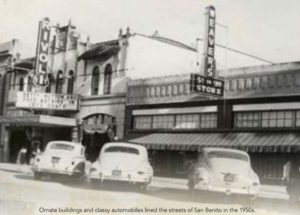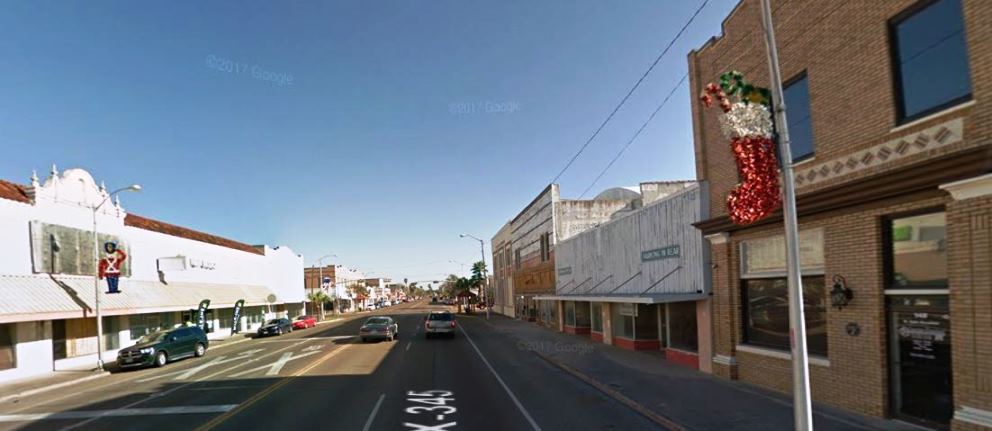San Benito was founded by Colonel Sam Robertson in 1904 during his pursuits of railroad expansions in south Texas. Robertson was brought to the region when he obtained a subcontract for track laying, surfacing, and bridge construction of the St. L.B. and M extension from Corpus Christi to Brownsville in 1903. As he built the railroad spider web in San Benito, he joined James Landrum and Oliver Hicks to form the San Benito Land and Water Company, which laid the infrastructure for an agriculture industry. With the railway connection, San Benito became an important player in the regional economy of the Lower Rio Grande Valley.
 During the 1940s and 1950s, San Benito was home to a thriving downtown district which attracted visitors many times over. Gradually however, commerce transitioned
During the 1940s and 1950s, San Benito was home to a thriving downtown district which attracted visitors many times over. Gradually however, commerce transitioned
from the downtown away from its historical agricultural economic and retail base towards larger, consumer goods stores off of major corridors in Harlingen and Brownsville. Like most downtowns throughout the country, downtown San Benito began to experience disinvestment in the 1960s with the onset of suburban migration and nearly universal car ownership which continues even today.
Now, San Benito has a catalyst – a vision that stimulates a coordinate set of public and private initiatives and investment – one that stimulates and spurs a new wave of growth. Accordingly, this Plan sets forth this vision and a implementable plan of action for the downtown area.
Ric Madrigal wants to do his part to help revive the long rows of empty storefronts marring historic buildings in downtown San Benito, Texas. So he bought a building from his mother Dulce Madrigal.
“It’s a big challenge,” said Madrigal, whose family owns an insurance company. “I want to do my part. Hopefully, other owners can do that.”
Madrigal’s purchase comes as the city launches a project aimed at revitalizing the downtown, once the commercial hub of northern Cameron County. “I want to see what we can do to revitalize it,” Madrigal continued. “I don’t want my property to hold San Benito back.”
The downtown revitalization plan and the parks and recreation plan all make up what the city refers to as San Benito’s comprehensive plan. Downtown plays an important role in supporting economic innovation, talent attraction and retention.
According to the plan, downtown is a center for creativity and serves as an incubator for locally-grown businesses. In May of 2016, the comprehensive plan was presented by Aaron Tuley, vice president of Kendig Keast Collaborative, the firm tasked with writing the plan. The plan sets forth a vision specifically for the downtown area, which stimulates and coordinates public and private initiatives and investment.
A separate Downtown Revitalization Plan was also created. It states: “The San Benito Downtown Revitalization Plan (the “Plan”) is an independent but related component of the San Benito Comprehensive Plan (2015-2035). It attempts to synthesize the efforts of the City and of all those who are
interested in a culturally and economically strong downtown core through the identification of near- and longer-term goals and recommendations. More importantly, it lays out a vision and plan of action to achieve that vision. In this light, the Plan should be used more as a how-to strategy than a “plan” in the conventional sense.
So why is the downtown important? Downtowns have often been described as the “living rooms” of cities. More than any other place, they represent a city’s collective history, identity, and place-quality. Downtown is a community’s image-setter and is a barometer of a community’s overall quality of life. Most curious visitors to the city will want to visit downtown and they will make inferences about the whole community based upon what they see or experience there. A shabby downtown may imply that the city lacks sociability, doesn’t value civic or public life, and has nothing to offer that cannot be found everywhere (e.g., chain stores in auto-centric strip centers).
A lively downtown, on the other hand, says that the community is friendly and inviting, has depth and variety, and values its history. Essentially, a strong
downtown indicates a community is vibrant and healthy, which oftentimes acts as the catalyst for attracting new talent and investment to the entire city.”
“[The plan] provides the city with an implantable plan of action to spur a new wave of growth,” Tuley said. It avoids glossy “silver bullet” projects such as new sports stadiums and entertainment districts.
The plan favors the basic building blocks of sustainable urban neighborhoods, quality housing, basic public amenities, solid infrastructure, public spaces, everyday commercial services and a balance of basic everyday neighborhood institutions such as government buildings, schools and churches.
Originally named “Diaz” in honor of Porfirio Diaz, the Mexican President of the time, the name was later changed to “San Benito” in honor of Benjamin Hicks. He was a pioneer rancher whose charitable attitude endeared him to the population. The name was suggested by Rafael Moreno, the popular 90-year-old camp cook of the surveying party. Moreno suggested the name “San Benito” for his beloved “Saint Benjamin” Hicks.
San Benito was a village with a moderate number of homes, businesses, churches, and public schools several years before they were incorporated in 1911. The original map of the townsite was recorded 28 April 1907. The first school was established in 1907 with 48 pupils and Miss Kate Purvis as the teacher. The post office also opened in 1907.
Photo via Google Maps.
See full article in Valley Morning Star by Fernando del Valle.
See Downtown Revitalization Plan (a supplement to the comprehensive plan).

